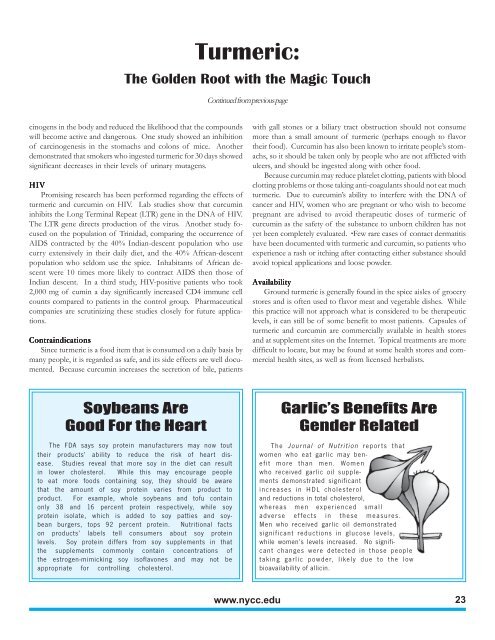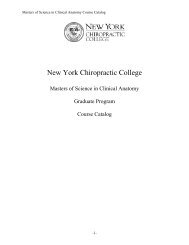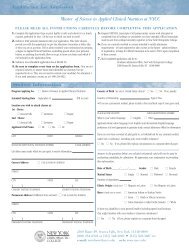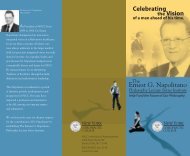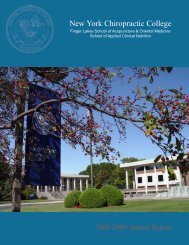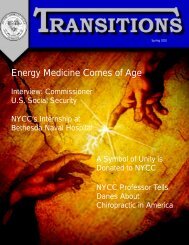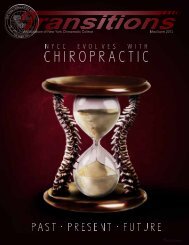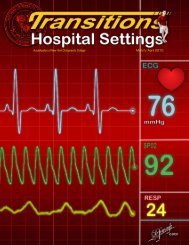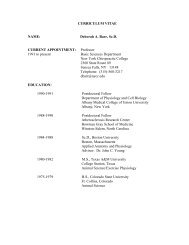2502 NYCC TRANS FINAL2 - New York Chiropractic College
2502 NYCC TRANS FINAL2 - New York Chiropractic College
2502 NYCC TRANS FINAL2 - New York Chiropractic College
Create successful ePaper yourself
Turn your PDF publications into a flip-book with our unique Google optimized e-Paper software.
Turmeric:<br />
The Golden Root with the Magic Touch<br />
Continued from previous page<br />
cinogens in the body and reduced the likelihood that the compounds<br />
will become active and dangerous. One study showed an inhibition<br />
of carcinogenesis in the stomachs and colons of mice. Another<br />
demonstrated that smokers who ingested turmeric for 30 days showed<br />
significant decreases in their levels of urinary mutagens.<br />
HIV<br />
Promising research has been performed regarding the effects of<br />
turmeric and curcumin on HIV. Lab studies show that curcumin<br />
inhibits the Long Terminal Repeat (LTR) gene in the DNA of HIV.<br />
The LTR gene directs production of the virus. Another study focused<br />
on the population of Trinidad, comparing the occurrence of<br />
AIDS contracted by the 40% Indian-descent population who use<br />
curry extensively in their daily diet, and the 40% African-descent<br />
population who seldom use the spice. Inhabitants of African descent<br />
were 10 times more likely to contract AIDS then those of<br />
Indian descent. In a third study, HIV-positive patients who took<br />
2,000 mg of cumin a day significantly increased CD4 immune cell<br />
counts compared to patients in the control group. Pharmaceutical<br />
companies are scrutinizing these studies closely for future applications.<br />
Contraindications<br />
Since turmeric is a food item that is consumed on a daily basis by<br />
many people, it is regarded as safe, and its side effects are well documented.<br />
Because curcumin increases the secretion of bile, patients<br />
with gall stones or a biliary tract obstruction should not consume<br />
more than a small amount of turmeric (perhaps enough to flavor<br />
their food). Curcumin has also been known to irritate people’s stomachs,<br />
so it should be taken only by people who are not afflicted with<br />
ulcers, and should be ingested along with other food.<br />
Because curcumin may reduce platelet clotting, patients with blood<br />
clotting problems or those taking anti-coagulants should not eat much<br />
turmeric. Due to curcumin’s ability to interfere with the DNA of<br />
cancer and HIV, women who are pregnant or who wish to become<br />
pregnant are advised to avoid therapeutic doses of turmeric of<br />
curcumin as the safety of the substance to unborn children has not<br />
yet been completely evaluated. Few rare cases of contact dermatitis<br />
have been documented with turmeric and curcumin, so patients who<br />
experience a rash or itching after contacting either substance should<br />
avoid topical applications and loose powder.<br />
Availability<br />
Ground turmeric is generally found in the spice aisles of grocery<br />
stores and is often used to flavor meat and vegetable dishes. While<br />
this practice will not approach what is considered to be therapeutic<br />
levels, it can still be of some benefit to most patients. Capsules of<br />
turmeric and curcumin are commercially available in health stores<br />
and at supplement sites on the Internet. Topical treatments are more<br />
difficult to locate, but may be found at some health stores and commercial<br />
health sites, as well as from licensed herbalists.<br />
Soybeans Are<br />
Good For the Heart<br />
The FDA says soy protein manufacturers may now tout<br />
their products’ ability to reduce the risk of heart disease.<br />
Studies reveal that more soy in the diet can result<br />
in lower cholesterol. While this may encourage people<br />
to eat more foods containing soy, they should be aware<br />
that the amount of soy protein varies from product to<br />
product. For example, whole soybeans and tofu contain<br />
only 38 and 16 percent protein respectively, while soy<br />
protein isolate, which is added to soy patties and soybean<br />
burgers, tops 92 percent protein. Nutritional facts<br />
on products’ labels tell consumers about soy protein<br />
levels. Soy protein differs from soy supplements in that<br />
the supplements commonly contain concentrations of<br />
the estrogen-mimicking soy isoflavones and may not be<br />
appropriate for controlling cholesterol.<br />
Garlic’s Benefits Are<br />
Gender Related<br />
The Journal of Nutrition reports that<br />
women who eat garlic may benefit<br />
more than men. Women<br />
who received garlic oil supplements<br />
demonstrated significant<br />
increases in HDL cholesterol<br />
and reductions in total cholesterol,<br />
whereas men experienced small<br />
adverse effects in these measures.<br />
Men who received garlic oil demonstrated<br />
significant reductions in glucose levels,<br />
while women’s levels increased. No significant<br />
changes were detected in those people<br />
taking garlic powder, likely due to the low<br />
bioavailability of allicin.<br />
www.nycc.edu<br />
23


